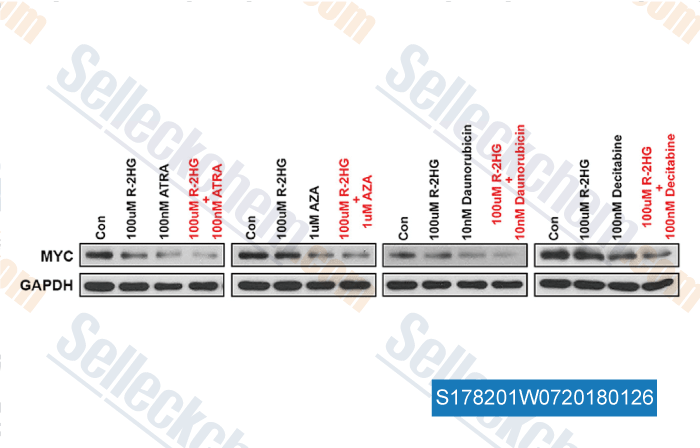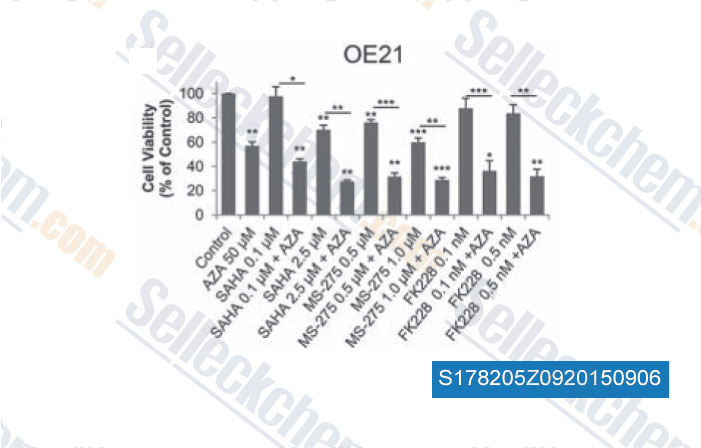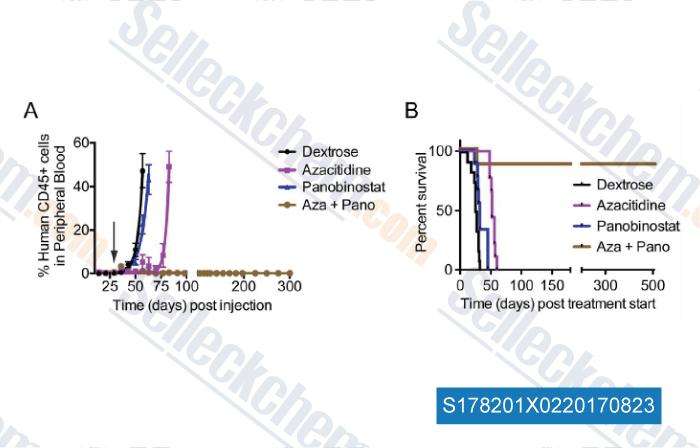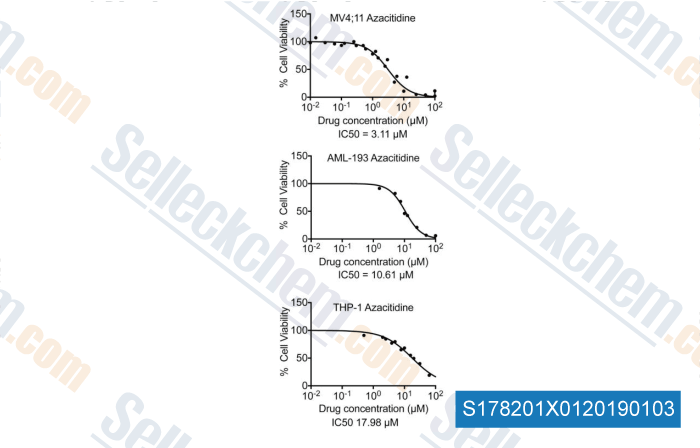|
Toll Free: (877) 796-6397 -- USA and Canada only -- |
Fax: +1-832-582-8590 Orders: +1-832-582-8158 |
Tech Support: +1-832-582-8158 Ext:3 Please provide your Order Number in the email. |
Technical Data
| Formula | C8H12N4O5 |
|||
| Molecular Weight | 244.2 | CAS No. | 320-67-2 | |
| Solubility (25°C)* | In vitro | DMSO | 48 mg/mL (196.56 mM) | |
| Water | Insoluble | |||
| Ethanol | Insoluble | |||
|
* <1 mg/ml means slightly soluble or insoluble. * Please note that Selleck tests the solubility of all compounds in-house, and the actual solubility may differ slightly from published values. This is normal and is due to slight batch-to-batch variations. * Room temperature shipping (Stability testing shows this product can be shipped without any cooling measures.) |
||||
Preparing Stock Solutions
Biological Activity
| Description | Azacitidine (5-Azacytidine, 5-AzaC, Ladakamycin, AZA, 5-Aza, CC-486,NSC 102816) is a nucleoside analogue of cytidine that specifically inhibits DNA methylation by trapping DNA methyltransferases. Azacitidine induces mitochondrial apoptosis and autophagy. | |
|---|---|---|
| Targets |
|
|
| In vitro | Azacitidine is widely used to demonstrate the correlation between loss of methylation in specifc gene regions and activation of the associated genes. After incorporation into DNA, Azacitidine inhibits DNA methyltransferase noncompetitively, causing a block in cytosine methylation in newly replicated DNA but not in resting, nondividing cells. [1] Azacitidine induces differentiation of Friend Erythroleukemia Cell C3H10T1/2 with myotube formation. [2] Azacitidine can be activated to the nucleoside triphosphate and incorporate into both DNA and RNA, leading to inhibition of DNA, RNA and protein synthesis in normal eukaryotic cells and in cancer cell lines, which could finally leads to cell death. Azacitidine also inhibits the incorporation of purine metabolites into macromolecules. Azacitidine inhibits the L1210 cells growth with IC50 and of 0.019 μg/mL. [3] |
|
| In vivo | Azacitidine inhibits polynucleotide synthesis in leukemic BDF1 mice. [3] Azacitidine (3 mg/kg, i.p.) increases the mean survival time in leukemic BDF1 mice inoculated with Ll210 ascites tumor cells. Azacitidine markedly suppresses all enzymes activity in the polyamine-biosynthetic pathway, including ornithine decarboxylase activity. putrescine-dependent S-adenosyl-L-methionine decarboxylase activity, and spermidine-dependent S-adenosyl-L-methionine decarboxylase activity. Azacitidine also inhibits the accumulations of polyamines in leukemic mice. [4] |
Protocol (from reference)
| Cell Assay: |
|
|---|---|
| Animal Study: |
|
References
Customer Product Validation

-
, , Cell, 2018, 172(1-2):90-105

-
Data from [Data independently produced by , , Epigenetics, 2015, 10(5): 431-45]

-
Data from [Data independently produced by , , Leuk Res, 2017, 58:91-97]

-
Data from [Data independently produced by , , Leuk Res, 2018, 58:91-97]
Selleck's Azacitidine (5-Azacytidine) has been cited by 115 publications
| S-nitrosothiol homeostasis maintained by ADH5 facilitates STING-dependent host defense against pathogens [ Nat Commun, 2024, 15(1):1750] | PubMed: 38409248 |
| Genomic and transcriptomic profiling of peripheral T cell lymphoma reveals distinct molecular and microenvironment subtypes [ Cell Rep Med, 2024, 5(2):101416] | PubMed: 38350451 |
| Panobinostat sensitizes AraC-resistant AML cells to the combination of azacitidine and venetoclax [ Biochem Pharmacol, 2024, S0006-2952(24)00048-0] | PubMed: 38373594 |
| Nuclear translocation of cleaved PCDH9 impairs gastric cancer metastasis by downregulating CDH2 expression [ iScience, 2024, 27(2):109011] | PubMed: 38357662 |
| 5-AZA Upregulates SOCS3 and PTPN6/SHP1, Inhibiting STAT3 and Potentiating the Effects of AG490 against Primary Effusion Lymphoma Cells [ Curr Issues Mol Biol, 2024, 46(3):2468-2479] | PubMed: 38534772 |
| DNA hypomethylation silences anti-tumor immune genes in early prostate cancer and CTCs [ Cell, 2023, 186(13):2765-2782.e28] | PubMed: 37327786 |
| 3D genome mapping identifies subgroup-specific chromosome conformations and tumor-dependency genes in ependymoma [ Nat Commun, 2023, 14(1):2300] | PubMed: 37085539 |
| Uridine-cytidine kinase 2 potentiates the mutagenic influence of the antiviral β-d-N4-hydroxycytidine [ Nucleic Acids Res, 2023, 10.1093/nar/gkad1002] | PubMed: 37953355 |
| Aspartyl-tRNA synthetase 2 orchestrates iron-sulfur metabolism in hematopoietic stem cells via fine-tuning alternative RNA splicing [ Cell Rep, 2023, 42(10):113264] | PubMed: 37838946 |
| Sensitivity to targeted UBA1 inhibition in a myeloid cell line model of VEXAS syndrome [ Blood Adv, 2023, 7(24):7445-7456] | PubMed: 38091008 |
RETURN POLICY
Selleck Chemical’s Unconditional Return Policy ensures a smooth online shopping experience for our customers. If you are in any way unsatisfied with your purchase, you may return any item(s) within 7 days of receiving it. In the event of product quality issues, either protocol related or product related problems, you may return any item(s) within 365 days from the original purchase date. Please follow the instructions below when returning products.
SHIPPING AND STORAGE
Selleck products are transported at room temperature. If you receive the product at room temperature, please rest assured, the Selleck Quality Inspection Department has conducted experiments to verify that the normal temperature placement of one month will not affect the biological activity of powder products. After collecting, please store the product according to the requirements described in the datasheet. Most Selleck products are stable under the recommended conditions.
NOT FOR HUMAN, VETERINARY DIAGNOSTIC OR THERAPEUTIC USE.
